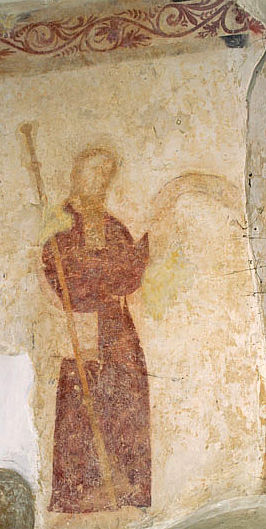Hales, Norfolk (†unknown ?Norwich) C.14
St James the Great

St James the Great, described in the Bible as the son of Zebedee and the brother of John, was the patron saint of pilgrims and pilgrimages in the Middle Ages. His own great shrine at Compostela in northern Spain was the most popular in the Christian world after Jerusalem and Rome.
There are a few paintings of him left in the English parish church, and he is sometimes found on painted screens. Here he looks less obviously like a pilgrim than he sometimes does elsewhere, but he has his pilgrim’s staff in his right hand and perhaps once wore a traditional pilgrim’s hat, as in the painting at Belton, not far away. It may be that the church at Hales was one that pilgrims visited en route – to Walsingham or the Holy Rood of Bromholm further north in Norfolk, south to Canterbury like Chaucer’s pilgrims, or to Lowestoft or Felixstowe to take ship for pilgrimage abroad. And there were any number of smaller local shrines in this area, as everywhere.
James is holding a faded scroll in his left hand. What was written on it is long gone, but it was possibly his ‘Article’ – ‘Who was conceived by the Holy Ghost, born of the Virgin Mary’ – according to the old belief that each of the points in the Apostles’ Creed was actually ‘contributed’ by an individual Apostle.¹
It is just possible in this photograph to make out (above and to the left of James) the beginning of the curve of the 12th century apsidal chancel, with its scrollwork border where it meets the roof. This too was painted at one time, and there are some faint traces left. In the nave, opposite James, is a figure behind the reading desk who may be John the Baptist; there is also a partly uncovered painting of St Christopher, and two angels with very large trumpets high up at either side of the chancel arch. This latter is probably the remains of a 15th century Doom.
¹ Although authorities sometimes differ on which Article belongs to which Apostle. This is the one given to James in the 15th century stained glass at Fairford, Gloucester (not to be missed by anyone in that area).